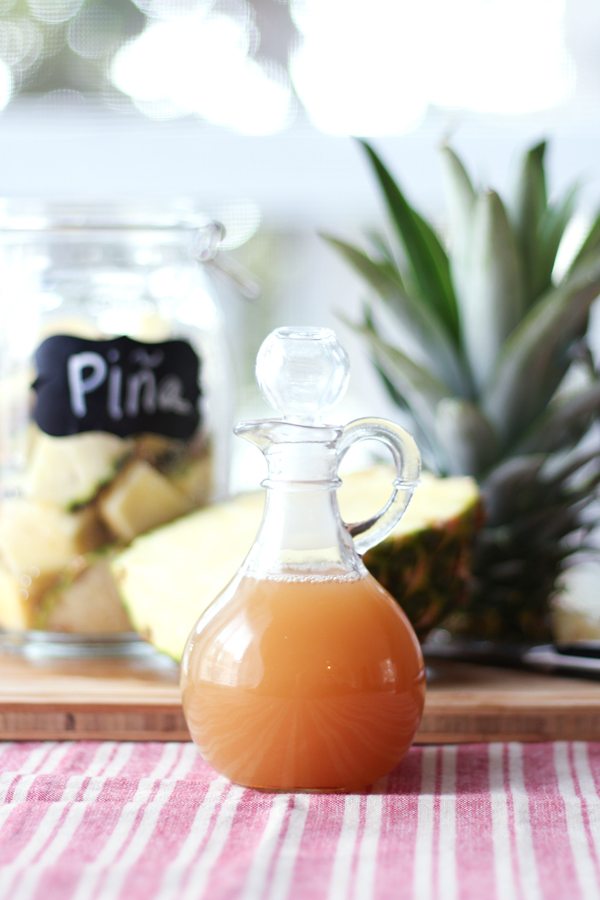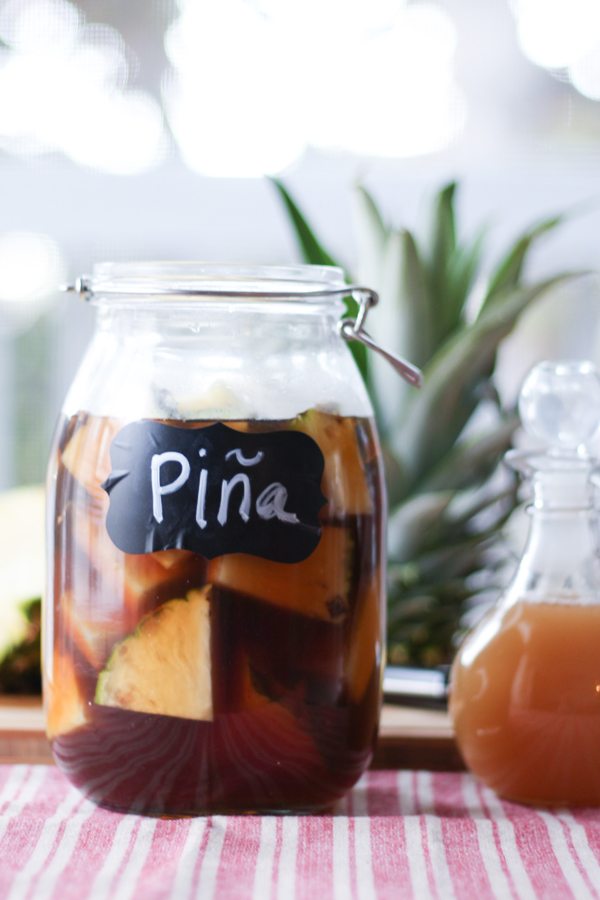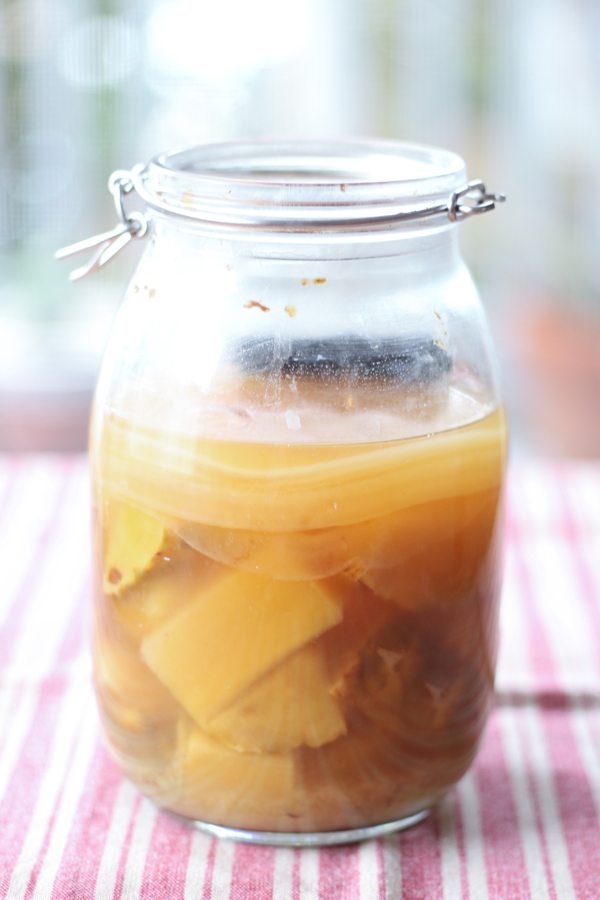Hi Friends! Today I am bringing you a recipe that will liven up any salad dressing, stir-fry, veggie dish or sauce and has many health benefits. I am going to show you how to make raw pineapple vinegar. This recipe was given to me by my husband’s Grandmother, Abue Queta, when we visited her in Mexico over Christmas. It’s sour and tangy like most vinegars but with a hint of pineapple flavor. Enough pineapple flavor to bring new life to boring salads and sautéed greens. It’s easy to make too. I promise.
In December I got the pleasure of meeting my husband’s big Mexican Family in Cuernavaca, Mexico. It was quite the experience. I had no idea what Cuernavaca was like, its size and barely its location. I decided to experience it from a beginners mind and be surprised. For some reason I thought it was a small town in Mexico, but turns out it’s a big city. Crammed with people and beautiful historic buildings. On a clear day in the morning you can see a volcano from Eric’s grandmother’s porch.
I had so much fun exploring the city and seeing Mexico from a local’s point of view. We explored food markets that felt like a maze that only the locals knew how to navigate and took a trip to a quaint, country town. I met Eric’s gigantic family. Each day we were in Cuernavaca, I met a new uncle, aunt or cousin and their families. I got to brush up on my Spanish speaking skills which was a huge bonus and learn to make some fermented foods too.
Eric’s grandmother, Queta, who they affectionately call Abue (which is short for Abuela and means grandmother in spanish) is an amazing soul and wonderful cook. Everyday she would cook us yummy food. We had fresh tortillas on the first day, chicharrón (fried pig skin) tacos , chicken mole verde, bbq ribs, cesina and many more mouth watering dishes. I learned that she made fermented foods of her own; a fermented pineapple drink and raw pineapple vinegar that she showed me how to make.
I couldn’t wait to get home to try the recipes she gave me. I knew they would be amazing based off what a wonderful cook Abue Queta is.
Some of the health benefits of raw pineapple vinegar
Like raw apple cider vinegar, raw pineapple vinegar has much of the same health benefits.
- Improves digestion.
- Reduces inflammation.
- Supports and strengthens the immune system.
- Helps your body absorb nutrients better.
What to expect when making vinegar
Raw Pineapple Vinegar is made with pineapple, brown sugar, cloves and water. All the ingredients are added to a glass jar and covered with a cloth to allow it to breathe. It needs to be stirred every few days to aerate and prevent any mold from growing on the surface. I didn’t experience any mold while making mine, but if you do, just scrape it off the top.
It will start to get bubbly and smell amazing at about 5 days. After a few weeks the liquid will start to get clearer, less cloudy and take on a sour taste and smell.
A mother will start to form on the surface that looks like a kombucha SCOBY. The mother is a combination of bacteria and yeast, is light brown, opaque in color and feels like jelly. You can save the mother and add it to your next batch of vinegar to cut down on fermentation time.
Adding raw vinegar to your diet has many health benefits and raw pineapple vinegar is unlike any vinegar you can buy from the store. Its tangy and sour as expected of vinegar but with a hint of pineapple. You can actually taste pineapple in it. Amazing!
- ½ pineapple
- 4 cups water
- 1 cup brown sugar
- 2 whole cloves
- Cut up the pineapple into big chunks and leave the skins on.
- Mix the the brown sugar in 4 cups of water until sugar dissolves.
- Add the pineapple and the sugar water to a glass jar.
- Add in the cloves.
- Cover with a cloth and secure with a rubber band.
- Store in a cool, dark place (away from direct sunlight) for 3-4 weeks.
- Stir the pineapple every few days to aerate it and prevent mold from growing on the surface.
- If mold forms on the surface, scoop it out. Don't worry, the vinegar is still good.
- Taste the vinegar after 3 weeks. If it tastes sour and acidic like vinegar, strain out the pineapple chunks and bottle it. If not, let it ferment for another week. Repeat until it tastes like vinegar.
- Store in a glass container or bottle in your pantry for several months to a year.
I’ve been dreaming up all sorts of uses for this tasty vinegar; salad dressing, stir-fry, marinades and healthy vinegar drinks. Substitute raw apple cider vinegar for this raw pineapple vinegar in my Apple Cider Vinegar And Honey Drink recipe. It’s sooo good!
If you are someone who regularly uses raw apple cider vinegar, give this recipe a shot and use raw pineapple vinegar instead as a nice change. Give it a try and let me know what you think in the comments below.
Resources & Articles
Apple Cider Vinegar And Honey Drink recipe.
What are the health benefits of pineapple?
So Easy Pineapple Vinegar (Oh Sweet Probiotics!)







I did this following directions exactly… And it has been 4 weeks, and it tastes absolutely amazing!! This is coming from a vinegar connisseur. I typically consume Braggs raw ACV on a daily basis. But my concern is, that it registers at 4.5% acidity right now but it never formed any mold whatsoever. There is much sedimentation on the bottom, assuming mother….. So is this still a good batch even without growing any mold on top??
Hi Kathy, I’m so glad you like the vinegar! Don’t worry if it hasn’t formed a mother on the surface yet. Mine did the same. It had sediment on the bottom at first and then formed a mother later. Give it more time and a mother will form on the top.
you don’t want mold, that kills the bacteria and yeast colony and poisons the body…
if green or black on top, then toss it you’re living organism colony of bacteria and yeast (you’re workers) have been infected with poisonous killers
Hi Kathy, could you tell me please how you measured your acidity?
Hi Danielle. I made this 05/20/15 in one batch and speared into two glass containers… As of today, one container looks clear and tastes sweet however the other is murky and tastes bitter. Any thoughts?
Hi Brenda,
Is it possible that the sugar wasn’t completely dissolved before you separated the batch? Are they stored in the same place? A warmer area will cause it to ferment faster. Possibly one is fermenting faster than the other. I would leave it alone and let them both continue to ferment. You have a few more weeks to go. Let me know if you have any more questions.
Hmmm… The only difference between the two containers is size. They both looked the same in color when I placed them side-by-side, where they remain. I was wondering about the difference in flavor as its my first time making raw vinegar.
I will let you know how they turn out in 2-3 weeks! :-)
Yes, please let me know :)
Wow, this sounds amazing, do you think it would work the same using coconut sugar or raw cane sugar? Really curious to try this!
Hi Chantelle,
You could use raw cane sugar in place of the brown sugar, but it wouldn’t be the same. The molasses in the brown sugar truly adds a nice flavor. The process of making the vinegar eliminates all sugar in the end product so you don’t have to worry about using sugar in a recipe like this.
Since brown sugar is actually white sugar with molasses, seems like you could just add some to your sucanat or whatever. Probably unsulfured? 1T to a cup of sugar = light brown, give the spoon a light smear of oil first and the molasses will slide right out.
exactly..
I want to make this vinegar, but have questions. You say it keeps for 2 months. That’s a LOT of vinegar to use in 2 months (most of us use many different vinegars, not just one). So, what happens at 2 months? Can it be cooked or something to stop the fermentation? I’d like to give some as gifts. I’m thinking of getting a big pineapple, cutting the skin off very thickly, and using that and the core to make my vinegar, leaving me with some lovely pineapple to eat fresh. Will that work?
Hi Diane,
I made my vinegar over 4 months ago and it is still good. I did some digging and vinegar doesn’t go bad or expire. You can give it away as gifts and as long as it’s stored in a cool, dry place it will be fine for several months.
Yes, you can use just the skin to make the vinegar too. I’ve seen recipes made that way. I demonstrated it with the fruit, because that is how grandma made it. Let me know how it turns out :)
HI DIANE, HERE IN PUERTO RICO IT WAS ALSO A TRADITION TO MAKE PINEAPPLE VINEGAR. AND I REMEMBER MY GRANDMOTHERS & MY MOTHER MAKING IT AND THAT IT WOULD BE KEPT IN USE FOR MANY MONTHS, NOT JUST 2.
I just used the skins and core.
It will keep for several months, maybe a few years. I still have some of this batch from 1 year ago and it’s still great.
Yes, you can use the skins and cores.
Thanks! Just what I wanted to hear.
HOLA DANIELLE,
I CONGRATULATE YOU ON POSTING THIS LATIN AMERICAN “SECRET”. I AM FROM PUERTO RICO AND I REMEMBER MY GRANDMOTHERS AND MOTHER USED TO MAKE PINEAPPLE VINEGAR, THEREFORE, IT WAS ALWAYS ON THE TABLE TO POUR IT OVER OUR FOOD. I’VE MADE IT MYSELF A FEW TIMES. HOWEVER, I MUST CONFESS I HAVEN’T MADE IT IN A FEW YRS. SO THANK YOU FOR THE REMINDER, AS I MUST SAVE SOME MONEY NOW, AS THE ORGANIC ACV IS MORE EXPENSIVE HERE THAN IT IS IN THE U.S. KEEP UP THE GOOD WORK AND GOD BLESS YOU.
BY THE WAY, GREAT PICS, THNX FOR SHARING THEM. MEXICO IS SUCH A BEAUTIFUL COUNTRY WITH A WONDERFUL CULTURE.
Thank you Giangeet!
Hello! I have a question for you! I’m now about 2.5 weeks into making the vinegar. I tasted it today and it tastes awful – (like pineapple going bad). Have I done something wrong (or is this normal)? I now realise that everytime bubbles started to form on the top, i was scooping it out. was this a mistake? Do you have any suggestions? Thanks! I’m super excited to have this recipe work out!
Sounds like it needs to ferment longer. Keep fermenting until it tastes like vinegar. Skimming the bubbles off the top is the right thing to do. Vinegar can take a long time. Don’t worry if it needs more than 3 weeks.
Thank you for your response! I have another question – it’s been almost
5 weeks, and mine doesn’t look anything like the one in your pretty
picture! mine’s a clear yellow, and tastes watery (almost like a bad
watery wine). I never really got a mother in mine (although, there is a
lot of sediment at the bottom). do you think i should start over or
have any suggestions on where i went wrong? thanks!
If it tastes like a bad wine, then it still hasn’t passed the alcohol stage and needs more time to turn to vinegar. Once it turns vinegar it will develop a mother. Vinegar can take months to make sometimes, especially if the weather is still cool. I would let it ferment longer.
thank you for the explanation! do you ever add more water & sugar to the mixture, as the water evaporates?
No. Don’t add more.
Hi! I hope you can help me with my dilemma. Me and my groupmates tried to make pineapple vinegar for a science project. However, we forgot to strain the pineapple parts after the given time period. After about two months, we checked on it and saw bugs inside the container. We plan on starting again from scratch. Do you have any ideas on how we’d be able to dispose the first batch of pineapple vinegar (the one with bugs on it)? I’m afraid that if we just pour it down the drain, the bugs might survive and live in the pipes. Thanks in advance! :)
Hi Diane, I don’t think you need to worry about the bugs in the pipes. You could throw it in a compost pile, the trash or garbage disposal.
Hello, I am currently attempting to ferment pineapple vinegar. It has been in the jar for a month and no mother had developed?? Could it need more time or sugar or do you think something has gone wrong? There is no mold and it tastes like tepache.
Nothing’s gone wrong. It needs more time. Temperature can make it go slowly if the weather is cooler. Give it more time and it will ferment into vinegar.
This is About 3 weeks. Hubby (Salvadoreño) says it can be used after 7 days. How do i really know?
It is really beautiful though.
https://uploads.disquscdn.com/images/016677fe8393e3c7c010a89255838a5d9704fc8b6b06fa1c9fa3ca9d03e0bd65.jpg 3
When i opened it it fizzed like soda pop…smells sweet taste sweet?
Hello Danielle, after reading your article, I want to start making the same. However, you forgot to mention whether the pineapple being used for it is organic or just a regular pineapple. Seeing that you have included them in the ferment. The way I understand it is that you can only include the skin or peels in the fermentation if the fruit is organic or it doesn’t matter. Please specify as it might affect the end result of the fermentation.
Danielle, do you HAVE to use the pineapple skin? It’s hard for me to find an organic pineapple where I live, so I’m wondering if I can still make this without the skin. Thank you.
No, you don’t have to use the skins. You can remove the skins to make this.
Hello again Diane, my apple cider vinegar and pineapple vinegar have developed a “MOTHER” of their own. Once I bottle the liquid, how do I preserved the MOTHERS so they don’t dry up and I can use them again in the next batch? Please advise. Thank you.
Store them in the same vinegar they were made from. You can put just enough to cover the mother and store in a glass container with a lid.
Hi Danielle :) we’re making a school investigatory project this school year. And we were hoping you would let us use your procedure of making Raw Pineapple Vinegar with a little innovation. If so, may we know your email address for much more formal communication. Thank you!
Hello! I will try this recipe :) I have a pineapple that is old, already fermenting itself, will this one work? Or its better for the pineapple to be fresh? Also, it is not organic..should I wash its peel with vinegar before? Or use only the flesh? What would you recommend?
Thanks!
Hi D
I have some pineapple that I bought at Walmart it is already chopped and has the skin cut off, it smells like it is fermented but not sure. CAN I use it
Hi Danielle, Do you keep stirring the mother in every couple of days? Do you leave it in the vinegar when you begin to strain?
No need to stir it. I don’t leave it in the vinegar when I strain it, because I like it more clear for using.
Perfect, I am going to give it a try
Hi, I hope you’re still responding to these posts. I am currently into my first month of making ACV, banana and pineapple vinegar. I strained all of them today into sterilized jars with airlocks for the second time. The first time I strained the fruit out. The ACV smells just like the dandelion wine I use to make. So all is good. The banana smells fantastic. So also good. The pineapple smells like urine. It had a white film on top before I strained it. Should I dump it or let it go a few more months?